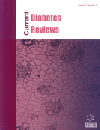- Home
- A-Z Publications
- Current Diabetes Reviews
- Previous Issues
- Volume 8, Issue 5, 2012
Current Diabetes Reviews - Volume 8, Issue 5, 2012
Volume 8, Issue 5, 2012
-
-
Biomarkers of Diabetic Nephropathy, the Present and the Future
More LessAuthors: Belinda Jim, Jolina Santos, Fuad Spath and John Cijiang HeDiabetic nephropathy (DN) is a leading cause of end-stage renal disease. Searching for the perfect biomarker of DN has become the holy grail of nephrology since the burden of this disease is untenable. The only feasible way to tackle this health care crisis is by prevention and treatment in a mechanistically rational approach. Therefore, the discovery of a specific, reliable diagnostic and prognostic biomarker for DN is imperati Read More
-
-
-
Relaxin, Insulin and Diabetes: An Intriguing Connection
More LessAuthors: Daniele Bani, Alessandro Pini and Samuel Ka-Sheng YueUntil recently, relaxin and insulin were grouped into the same hormone superfamily because of substantial biochemical homologies. This notion has then changed with the understanding that insulin and relaxin are ligands for different receptors and signal transduction systems, namely, tyrosine kinase and G-protein-coupled receptors respectively. As a matter of fact, relaxin does not mimic the metabolic effects of insulin. The biol Read More
-
-
-
Genetic Association Studies in Diabetic Nephropathy
More LessAuthors: Harvest F. Gu and Kerstin BrismarClinical observations and epidemiological studies have shown that there is familial aggregation of diabetic nephropathy in many ethnic groups, indicating the strong contribution of inherited factors in the development of diabetic nephropathy. Identification of the genes involved in the pathogenesis of diabetic nephropathy may provide better knowledge of its pathophysiology and future therapies. To search for the gene Read More
-
-
-
Glycaemic Variability and Pancreatic ß-cell Dysfunction
More LessAuthors: Klaus-Dieter Kohnert, Ernst-Joachim Freyse and Eckhard SalzsiederThe importance of glycaemic variability (GV) as a factor in the pathophysiology of cellular dysfunction and late diabetes complications is currently a matter of debate. However, there is mounting evidence from in vivo and in vitro studies that GV has adverse effects on the cascade of physiological processes that result in chronic ß-cell dysfunctions. Glucose fluctuations more than sustained chronic hyperglycaemia can induce excess Read More
-
-
-
Circadian Rhythm of Blood Pressure in Diabetes Mellitus: Evidence, Mechanisms and Implications
More LessAuthors: Elena Matteucci and Ottavio GiampietroCircadian misalignment has been implicated in the development of diabetes mellitus and cardiovascular disease. Circadian rhythms of blood pressure (BP) and heart rate (HR) have long been known and the mechanisms controlling them have been actively investigated in physiology and disease. In this respect, the introduction of 24-hour ambulatory blood pressure monitoring (ABPM) has enabled a more accurate assess Read More
-
-
-
Glucagon and Cyclic AMP: Time to Turn the Page?
More LessIt is well established that glucagon can stimulate adipose lipolysis, myocardial contractility, and hepatic glucose output by activating a GPCR and adenylate cyclase (AC) and increasing cAMP production. It is also widely reported that activation of AC in all three tissues requires pharmacological levels of the hormone, exceeding 0.1 nM. Extensive evidence is presented here supporting the view that cAMP does not mediate metab Read More
-
-
-
Islets From Rats and Pigs Transgenic for Photogenic Proteins
More LessTranslational research is necessary for the development of efficient experimental animal models that can be used to develop innovative medical treatments, such as improvements in organ or tissue transplantation. We have developed animal models that produce photogenic proteins in their islet cells: rats models expressing the gene for luciferase or green fluorescent protein (GFP), and pig models expressing the gene for GF Read More
-
-
-
oa Lipid Composition of Cell Membranes and Its Relevance in Type 2 Diabetes Mellitus
More LessIdentifying the causative relationship between the fatty acid composition of cell membranes and type 2 diabetes mellitus fundamentally contributes to the understanding of the basic pathophysiological mechanisms of the disease. Important outcomes of the reviewed studies appear to support the hypotheses that the flexibility of a membrane determined by the ratio of (poly)unsaturated to saturated fatty acyl chains of its phosp Read More
-
Volumes & issues
-
Volume 21 (2025)
-
Volume 20 (2024)
-
Volume 19 (2023)
-
Volume 18 (2022)
-
Volume 17 (2021)
-
Volume 16 (2020)
-
Volume 15 (2019)
-
Volume 14 (2018)
-
Volume 13 (2017)
-
Volume 12 (2016)
-
Volume 11 (2015)
-
Volume 10 (2014)
-
Volume 9 (2013)
-
Volume 8 (2012)
-
Volume 7 (2011)
-
Volume 6 (2010)
-
Volume 5 (2009)
-
Volume 4 (2008)
-
Volume 3 (2007)
-
Volume 2 (2006)
-
Volume 1 (2005)
Most Read This Month
Article
content/journals/cdr
Journal
10
5
false
en


